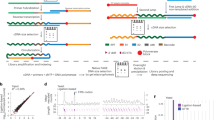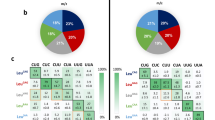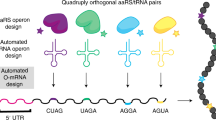Abstract
Stunning advances in the structural biology of multicomponent biomolecular complexes (MBCs) have ushered in an era of intense, structure-guided mechanistic and functional studies of these complexes. Nonetheless, existing methods to site-specifically conjugate MBCs with biochemical and biophysical labels are notoriously impracticable and/or significantly perturb MBC assembly and function. To overcome these limitations, we have developed a general, multiplexed method in which we genomically encode non-canonical amino acids (ncAAs) into multiple, structure-informed, individual sites within a target MBC; select for ncAA-containing MBC variants that assemble and function like the wildtype MBC; and site-specifically conjugate biochemical or biophysical labels to these ncAAs. As a proof-of-principle, we have used this method to generate unique single-molecule fluorescence resonance energy transfer (smFRET) signals reporting on ribosome structural dynamics that have thus far remained inaccessible to smFRET studies of translation.

This is a preview of subscription content, access via your institution
Access options
Access Nature and 54 other Nature Portfolio journals
Get Nature+, our best-value online-access subscription
$29.99 / 30 days
cancel any time
Subscribe to this journal
Receive 12 print issues and online access
$259.00 per year
only $21.58 per issue
Buy this article
- Purchase on Springer Link
- Instant access to full article PDF
Prices may be subject to local taxes which are calculated during checkout




Similar content being viewed by others
Data availability
With the exception of the smFRET data, all other data supporting the findings of this study are presented within this article. Due to the lack of a public repository for smFRET data, the smFRET data supporting the findings of this study are available from the corresponding author upon request. Source data are provided with this paper.
Code availability
The code used to analyze the TIRF movies in this study is associated with a manuscript in preparation (J. Hon, C. Kinz-Thompson, R.L.G.), and is consequently available from the corresponding author upon request.
References
Frank, J. & Gonzalez, R. L. Jr. Structure and dynamics of a processive Brownian motor: the translating ribosome. Annu. Rev. Biochem. 79, 381–412 (2010).
Shajani, Z., Sykes, M. T. & Williamson, J. R. Assembly of bacterial ribosomes. Annu. Rev. Biochem. 80, 501–526 (2011).
Shoji, S., Dambacher, C. M., Shajani, Z., Williamson, J. R. & Schultz, P. G. Systematic chromosomal deletion of bacterial ribosomal protein genes. J. Mol. Biol. 413, 751–761 (2011).
Lotze, J., Reinhardt, U., Seitz, O. & Beck-Sickinger, A. G. Peptide-tags for site-specific protein labelling in vitro and in vivo. Mol. Biosyst. 12, 1731–1745 (2016).
Culver, G. M. & Noller, H. F. Efficient reconstitution of functional Escherichia coli 30S ribosomal subunits from a complete set of recombinant small subunit ribosomal proteins. RNA 5, 832–843 (1999).
Wang, H. H. et al. Programming cells by multiplex genome engineering and accelerated evolution. Nature 460, 894–898 (2009).
Lang, K. & Chin, J. W. Cellular incorporation of unnatural amino acids and bioorthogonal labeling of proteins. Chem. Rev. 114, 4764–4806 (2014).
Lang, K. & Chin, J. W. Bioorthogonal reactions for labeling proteins. ACS Chem. Biol. 9, 16–20 (2014).
Ermolenko, D. N. et al. Observation of intersubunit movement of the ribosome in solution using FRET. J. Mol. Biol. 370, 530–540 (2007).
Cornish, P. V., Ermolenko, D. N., Noller, H. F. & Ha, T. Spontaneous intersubunit rotation in single ribosomes. Mol. Cell 30, 578–588 (2008).
Wasserman, M. R., Alejo, J. L., Altman, R. B. & Blanchard, S. C. Multiperspective smFRET reveals rate-determining late intermediates of ribosomal translocation. Nat. Struct. Mol. Biol. 23, 333–341 (2016).
Sharma, H. et al. Kinetics of spontaneous and EF-G-accelerated rotation of ribosomal subunits. Cell Rep. 16, 2187–2196 (2016).
Wang, L. et al. Allosteric control of the ribosome by small-molecule antibiotics. Nat. Struct. Mol. Biol. 19, 957–963 (2012).
Marshall, R. A., Dorywalska, M. & Puglisi, J. D. Irreversible chemical steps control intersubunit dynamics during translation. Proc. Natl Acad. Sci. USA 105, 15364–15369 (2008).
Dorywalska, M. et al. Site-specific labeling of the ribosome for single-molecule spectroscopy. Nucleic Acids Res. 33, 182–189 (2005).
Rozov, A., Westhof, E., Yusupov, M. & Yusupova, G. The ribosome prohibits the G*U wobble geometry at the first position of the codon-anticodon helix. Nucleic Acids Res. 44, 6434–6441 (2016).
Zhou, J., Lancaster, L., Donohue, J. P. & Noller, H. F. How the ribosome hands the A-site tRNA to the P site during EF-G-catalyzed translocation. Science 345, 1188–1191 (2014).
Korostelev, A. et al. Interactions and dynamics of the Shine Dalgarno helix in the 70S ribosome. Proc. Natl Acad. Sci. USA 104, 16840–16843 (2007).
Jewett, J. C., Sletten, E. M. & Bertozzi, C. R. Rapid Cu-free click chemistry with readily synthesized biarylazacyclooctynones. J. Am. Chem. Soc. 132, 3688–3690 (2010).
Lajoie, M. J. et al. Genomically recoded organisms expand biological functions. Science 342, 357–360 (2013).
Yu, D. et al. An efficient recombination system for chromosome engineering in Escherichia coli. Proc. Natl Acad. Sci. USA 97, 5978–5983 (2000).
Amiram, M. et al. Evolution of translation machinery in recoded bacteria enables multi-site incorporation of nonstandard amino acids. Nat. Biotechnol. 33, 1272–1279 (2015).
Chin, J. W. et al. Addition of p-azido-l-phenylalanine to the genetic code of Escherichia coli. J. Am. Chem. Soc. 124, 9026–9027 (2002).
Wade, H. E. & Robinson, H. K. The inhibition of ribosomal ribonuclease by bacterial ribosomes. Biochem. J. 97, 747–753 (1965).
Kurylo, C. M. et al. Genome sequence and analysis of Escherichia coli MRE600, a colicinogenic, nonmotile strain that lacks RNase I and the type I methyltransferase, EcoKI. Genome Biol. Evol. 8, 742–752 (2016).
Cammack, K. A. & Wade, H. E. The sedimentation behaviour of ribonuclease-active and -inactive ribosomes from bacteria. Biochem. J. 96, 671–680 (1965).
Wang, H. H. & Church, G. M. Multiplexed genome engineering and genotyping methods: applications for synthetic biology and metabolic engineering. Method Enzymol. 498, 409–426 (2011).
Elvekrog, M. M. & Gonzalez, R. L. Jr. Conformational selection of translation initiation factor 3 signals proper substrate selection. Nat. Struct. Mol. Biol. 20, 628–633 (2013).
Fei, J., Kosuri, P., MacDougall, D. D. & Gonzalez, R. L. Jr. Coupling of ribosomal L1 stalk and tRNA dynamics during translation elongation. Mol. Cell 30, 348–359 (2008).
Fei, J. et al. A highly purified, fluorescently labeled in vitro translation system for single-molecule studies of protein synthesis. Methods Enzymol. 472, 221–259 (2010).
Milon, P., Maracci, C., Filonava, L., Gualerzi, C. O. & Rodnina, M. V. Real-time assembly landscape of bacterial 30S translation initiation complex. Nat. Struct. Mol. Biol. 19, 609–615 (2012).
Antoun, A., Pavlov, M. Y., Lovmar, M. & Ehrenberg, M. How initiation factors tune the rate of initiation of protein synthesis in bacteria. EMBO J. 25, 2539–2550 (2006).
Tourigny, D. S., Fernandez, I. S., Kelley, A. C. & Ramakrishnan, V. Elongation factor G bound to the ribosome in an intermediate state of translocation. Science 340, 1235490 (2013).
Ratje, A. H. et al. Head swivel on the ribosome facilitates translocation by means of intra-subunit tRNA hybrid sites. Nature 468, 713–716 (2010).
Graf, M. et al. Visualization of translation termination intermediates trapped by the Apidaecin 137 peptide during RF3-mediated recycling of RF1. Nat. Commun. 9, 3053 (2018).
Ramrath, D. J. et al. The complex of tmRNA-SmpB and EF-G on translocating ribosomes. Nature 485, 526–529 (2012).
Adiego-Perez, B. et al. Multiplex genome editing of microorganisms using CRISPR-Cas. FEMS Microbiol. Lett. 366, fnz086 (2019).
DiCarlo, J. E. et al. Yeast oligo-mediated genome engineering (YOGE). ACS Synth. Biol. 2, 741–749 (2013).
Cong, L. et al. Multiplex genome engineering using CRISPR/Cas systems. Science 339, 819–823 (2013).
Reyon, D. et al. FLASH assembly of TALENs for high-throughput genome editing. Nat. Biotechnol. 30, 460–465 (2012).
Thompson, D. B. et al. The future of multiplexed eukaryotic genome engineering. ACS Chem. Biol. 13, 313–325 (2018).
Carr, P. A. et al. Enhanced multiplex genome engineering through co-operative oligonucleotide co-selection. Nucleic Acids Res. 40, e132 (2012).
Ambrogelly, A. et al. Pyrrolysine is not hardwired for cotranslational insertion at UAG codons. Proc. Natl Acad. Sci. USA 104, 3141–3146 (2007).
Selmer, M. et al. Structure of the 70S ribosome complexed with mRNA and tRNA. Science 313, 1935–1942 (2006).
Murphy, M. C., Rasnik, I., Cheng, W., Lohman, T. M. & Ha, T. Probing single-stranded DNA conformational flexibility using fluorescence spectroscopy. Biophys. J. 86, 2530–2537 (2004).
DeLano, W. L. Pymol: An open-source molecular graphics tool. CCP4 Newsl. Protein Crystallogr. 40, 82–92 (2002).
Blanchard, S. C., Gonzalez, R. L., Kim, H. D., Chu, S. & Puglisi, J. D. tRNA selection and kinetic proofreading in translation. Nat. Struct. Mol. Biol. 11, 1008–1014 (2004).
Sternberg, S. H., Fei, J., Prywes, N., McGrath, K. A. & Gonzalez, R. L. Jr. Translation factors direct intrinsic ribosome dynamics during translation termination and ribosome recycling. Nat. Struct. Mol. Biol. 16, 861–868 (2009).
Wang, J., Caban, K. & Gonzalez, R. L. Jr. Ribosomal initiation complex-driven changes in the stability and dynamics of initiation factor 2 regulate the fidelity of translation initiation. J. Mol. Biol. 427, 1819–1834 (2015).
Fei, J., Richard, A. C., Bronson, J. E. & Gonzalez, R. L. Jr. Transfer RNA-mediated regulation of ribosome dynamics during protein synthesis. Nat. Struct. Mol. Biol. 18, 1043–1051 (2011).
Hussain, T., Llacer, J. L., Wimberly, B. T., Kieft, J. S. & Ramakrishnan, V. Large-scale movements of IF3 and tRNA during bacterial translation initiation. Cell 167, 133–144 e113 (2016).
Caban, K., Pavlov, M., Ehrenberg, M. & Gonzalez, R. L. Jr. A conformational switch in initiation factor 2 controls the fidelity of translation initiation in bacteria. Nat. Commun. 8, 1475 (2017).
Edelstein, A. D. et al. Advanced methods of microscope control using μManager software. J. Biol. Methods 1, e10 (2014).
Ning, W., Fei, J. & Gonzalez, R. L. Jr. The ribosome uses cooperative conformational changes to maximize and regulate the efficiency of translation. Proc. Natl Acad. Sci. USA 111, 12073–12078 (2014).
Bronson, J. E., Fei, J., Hofman, J. M., Gonzalez, R. L. Jr. & Wiggins, C. H. Learning rates and states from biophysical time series: a Bayesian approach to model selection and single-molecule FRET data. Biophys. J. 97, 3196–3205 (2009).
Acknowledgements
We thank H. Wang and J. Park for helpful discussions regarding MGE, B. Huang and H. Li for supplying useful reagents, and C. Kinz-Thompson and K. Caban for valuable feedback on the manuscript. This work was supported by funds to R.L.G. from the National Institute of Health (grant nos. R01 GM084288 and R01 GM137608).
Author information
Authors and Affiliations
Contributions
B.J.D. and R.L.G. designed the experiments. B.J.D. performed the experiments. B.J.D. and R.L.G. analyzed the results and wrote the manuscript. Both authors agreed to the final version of the manuscript.
Corresponding author
Ethics declarations
Competing interests
The authors declare no competing interests.
Additional information
Publisher’s note Springer Nature remains neutral with regard to jurisdictional claims in published maps and institutional affiliations.
Extended data
Extended Data Fig. 1 Site-specific Cy3 and/or Cy5 labeling of ribosomes purified from wildtype versus genomic mutant strains.
SDS-PAGE analysis of ribosomal proteins derived from 30 S or 50 S subunits isolated from the wildtype (wt) strain (Lanes 1 and 2) or the IR1, MT1, HS1, and HS2 mutant strains (Lanes 4-8) and reacted with DBCO-derivatized Cy3 and/or Cy5 fluorophores as shown in Fig. 3. Left panel shows visible light scan of Coomassie-stained gel. Middle and right panels show fluorescence emission scans of pre-Coomassie-stained gel using excitation wavelengths of 532 nm for Cy3 (Middle Panel) and 635 nm for Cy5 (Right Panel). The position at which each labeled ribosomal protein is expected to run on the SDS-PAGE gel was determined using a standard protein molecular weight ladder, and is indicated along the right side of the figure. The experiment shown here was replicated a total of three times, with similar results each time.
Extended Data Fig. 2 Idealized EFRET versus time trajectories generated using Bayesian inference-based hidden Markov modeling.
Representative Cy3- and Cy5 fluorescence intensity versus time trajectories (Top Sub-Panel) and corresponding EFRET versus time trajectories (Bottom Sub-Panel) for smFRET experiments performed on ribosomal complexes assembled using Cy3- and/or Cy5-labeled 30 S and/or 50 S subunits isolated from the (a and b) HS1, (c) MT1, and (d) IR1 strains as shown in Fig. 4. In the Cy3 and Cy5 fluorescence intensity versus time trajectories, the Cy3 and Cy5 fluorescence intensities are shown as green and red curves, respectively. In the EFRET versus time trajectories, the EFRET is shown as blue curves. The idealized EFRET versus time trajectory is shown as black lines.
Supplementary information
Supplementary Information
Supplementary Figs. 1–3 and Tables 1–5.
Source data
Source Data Fig. 3 and Extended Data Fig. 1
Three replicates of: unprocessed visible light scans of Coomassie-stained gels; unprocessed fluorescence scans of unstained gels with a 532-nm excitation source and unprocessed fluorescence scans of unstained gels with a 635-nm excitation source.
Rights and permissions
About this article
Cite this article
Desai, B.J., Gonzalez, R.L. Multiplexed genomic encoding of non-canonical amino acids for labeling large complexes. Nat Chem Biol 16, 1129–1135 (2020). https://doi.org/10.1038/s41589-020-0599-5
Received:
Accepted:
Published:
Issue Date:
DOI: https://doi.org/10.1038/s41589-020-0599-5
This article is cited by
-
Fluorescence resonance energy transfer at the single-molecule level
Nature Reviews Methods Primers (2024)
-
Insights into genome recoding from the mechanism of a classic +1-frameshifting tRNA
Nature Communications (2021)



